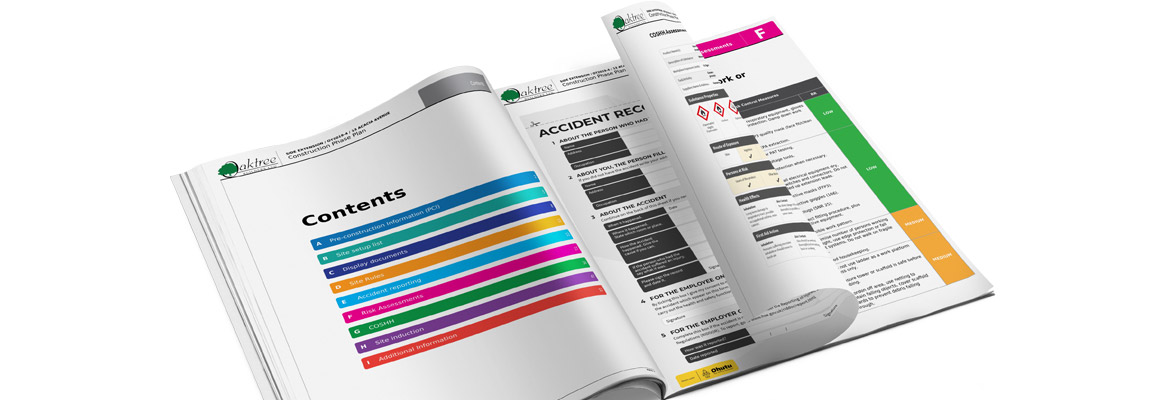First introduced under the Construction (Design and Management) Regulations 1994 (CDM), the Health and Safety file has remained a fixture for construction companies and building firms. Like many health and safety requirements, even small businesses must have one in place.
Although health and safety construction laws have been updated throughout the years, the latest CDM in 2015 ensured that firms must still maintain a Health and Safety file. It was designed to reduce the risk of harm to individuals building, using or maintaining structures. A Health and Safety file is critical during the planning stage of developments.
When do you need a Health and Safety file?
A Health and Safety file must be created if projects involve more than one contractor. The appointed Principal Designer is usually responsible for the creation and maintenance of the file. Although it is handed over to clients at the completion of the project. This ensures that it can be disseminated to other contractors or builders. By having access to the original file, future construction workers and designers can identify potential Health and Safety risks and mitigate them accordingly.
There are instances where the Principal Designer’s role may come to an end before the completion of the project. In such cases, the Principal Contractor should take over the responsibility for storing, maintaining and compiling the Health and Safety file.
What should it contain?
Every Health and Safety file should be pertinent to the particular project it’s created for. As such, they can vary quite significantly. However, there are general guidelines which can be used when compiling yours. For example, documents which are commonly included in it include:
- Description of the work carried out
- Hazards which remain present and were not eliminated during the design process or construction (in addition to any other action which was taken to minimise these hazards)
- Structural principles relating to the building(s), such as bracing.
- Information regarding safe working loads for roofs and floors
- Any hazardous materials which may have been used throughout the construction process
- Key information concerning the movement, dismantling or removal of equipment
- Health and Safety details regarding the maintenance or cleaning of the structure, if such equipment has been left
- Locations of key areas, such as safe access from security voids and fire doors
- The markings, location and type of services, including gas supplies, underground cables, fire-fighting equipment etc.
How extensive should it be?
A Health and Safety file is designed to provide information which could be relevant to future building or construction work. There is potentially a lot of information which could be included in it. However Principal Designers are only required to include details which are relevant to the planning of future works. Furthermore, the level of detail should be proportionate to the risks posed, so it may not be necessary to provide extensive information about potentially minor risk factors.
It is vital, however, that any information contained within it is clear, easy to interpret, accurate and concise. Future contractors should be able to identify potential health and safety risks upon reading the File, so it’s important that information is kept in context and is easy to decipher.
Principal Designers are not usually required to add information regarding contractual agreements. Neither details about the standard use of the structure or information about the construction process undertaken. Unless this is particularly pertinent to the health and safety of future works.
When should it be created?
Health and Safety files must be created before any type of construction begins. By devising a Health and Safety file in the pre-construction phase, Principal Designers can increase on-site safety and to mitigate risks.
However, creating a Health and Safety file is not a one-off task. The Principal Designer should create it prior to construction starting. The file should be reviewed, revised and updated throughout the project. This is to reflect any changes which have occurred throughout the construction phase.
If risks have not been mitigated by the design of the structure, these must be included in it. So these may need to be added during the course of construction. Furthermore, as the Principal Designers receives health and safety information from colleagues (such as the Principal Contractor) it will need to be updated to ensure all relevant information is present.
Working on an existing structure
If builders or contractors are carrying out works on an existing structure then they must consult the building’s Health and Safety file. They need to so this before work is commenced. In addition to this, the Principal Designer (or Principal Contractor if there is no Principal Designer) must take responsibility for updating it. This is to reflect the subsequent work which has been carried out. As well as citing any existing risks which remain or any new risks which have been introduced by the subsequent works.
How long should it be kept for?
A Principal Designer will take responsibility for the file until the project is complete. At which point it must be passed to the owners of the building. A Health and Safety file is kept for the lifetime of the building. It provides an accurate record of health and safety issues from when the structure was first erected. Right through to the latest works which may have been carried out.
Whilst some builders feel that creating one is an onerous task, there are a variety of apps and programs which can help you to collate an accurate and appropriate Health and Safety file. By collating the relevant information and creating a Health and Safety file, construction workers can increase safety within the industry and mitigate health and safety risks. Not just for themselves but for end-users and other workers in the industry.


